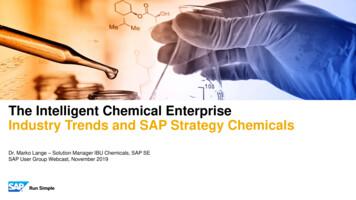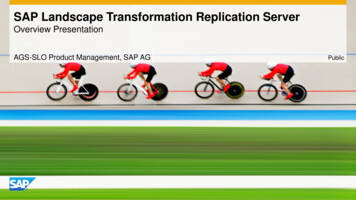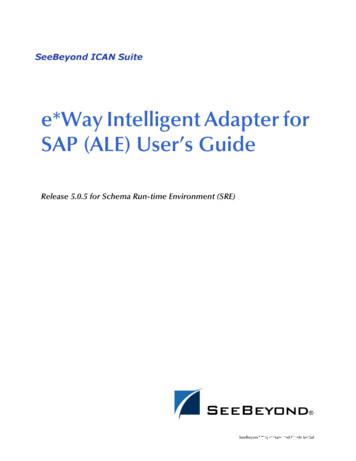How To Move An SAP BusinessObjects BI Platform System .
How to Move an SAP BusinessObjects BI PlatformSystem Database and Audit DatabaseTechnology Used SAP BI Platform 4.1 (this includes SAP BusinessObjects Enterprise 4.1, SAPBusinessObjects Edge 4.1 and SAP Crystal Server 2013)Microsoft SQL Server 2008 R2Microsoft SQL Server 2012BackgroundOur Support Team at DSCallards are regularly asked how to move the SAP BusinessObjects BIPlatform 4.1 Central Management System database and its Auditing database.The Central Management System (CMS) database is the database that sits behind the SAPBusinessObjects BI Platform 4.1 application. It has information about users, groups, Filestorelocations of Business Intelligence content stored within the application, and plays a critical part to theplatform.The Audit Database stores usage and activity related to the SAP BusinessObjects BI Platform 4.1system, with information such as who logs on, who runs what reports and when and more.I thought I would share the steps I took to do this.
Steps Performed1) Remote Desktop to the Server where the SAP BI Platform 4.1 is installed2) Open the Central Configuration Manager3) Once opened right click on the Server Intelligence Agent and select stop4) Take a backup the SAP BI Platform 4.1 Central Management System database and Auditdatabase
5) Take the backup of the Audit Database and restore the audit Audit database to new SQLServerEnsuring that all the same database owner and permissions are taken across with it6) Add a new 64-bit ODBC connection on the same server as the SAP BI Platform 4.1 server tothe restored Audit databasea) To access the 64-bit ODBC database administrator: C:\Windows\System32\odbcad32.exeb) Select the system DSN tabc) Click addd) Select the database driver for SQL Server, and click Finish
e) Give the data source a name and enter all the relevant details, but remember to select thenew database created when asked in the new data source creation screensf)Click finish once all the steps have been done and you have tested the connection thedata source is correct7) If during the SAP BI Platform 4.1 installation and setup you installed the Auditing Universe andReports which can be obtained from here: http://scn.sap.com/docs/DOC-6175 you will needto update any auditing connections used by the auditing universe using the Information DesignToolFollow these steps to update the auditing connectiona) Open the Information Design Tool (this tool is part of the SAP BI Platform 4.1 client toolsinstallation)b) Go to File New Project
c) Call the Project Auditing or a different name to one that maybe there already and click finishd) Right click on the auditing project you created above select new relational connection
e) Give the relational connection a new name and description if required and click nextf) Select the relevant database driver that corresponds to the new auditing database version, inthe next screen enter the details for the connection such as connection name, username andpassword, then click finish
Note: you will need to either create or update 64-bit and 32-bit ODBC connections to theauditing database so the universe can use this. Dependent if you have updated to a newerversion of SQL Server, both 64-bit and 32-bit ODBC connections have to have the same nameand using the same SQL Server database driver to the auditing database. (See below screenfor example)Please do not try and re-use the auditing ODBC connection updated in the previous steps asthe SAP BI Platform uses this to write data into the database, you need a separate one forreporting.g) the connection will appear under the project with a .cnx (local connection) and also appear asa tab on the right side of the application (as below)
h) the new .cnx local connection needs to be published back to the SAP BI Platform in order tosave the connection back to repository, right click on the Auditing-new.cnx under the projectworkspace and select ‘Publish Connection Object to a Repository’i)it will then ask you to connect to the SAP BI Platform RepositorySystem: enter the SAP BI PlatformServernameUsername: valid login for the SAP BIPlatform that allows administrationstasksUsername: password for the valid loginj)once the details are entered click connect, this should take you to the next screenk) define the folder where the connection will be published, recommendation to place it in a newfolder or in the root, then select finish
l)the application will inform you that it has successfully published a connection, and do you wishto create a connection shortcut, select yesm) this will create a .cns (connection shortcut) under the project workspacen) the next step is to update the data foundation layer, in order to do this you will need to retrievethe existing auditing universe already publishedRight click on the project workspace title under local projects and select Retrieve a PublishedUniverse From Repository
It will ask you to connect to the repository again to retrieve the auditing universe. This will reuse the connection you made earlier so you don’t need to enter the details againo) Find the auditing universe and select this, and click finish
The universe files are pulled down locally into the projectp) Double click on the .dfx (data foundation) file and this will open to the right, ensure you havethe connection tray selected (like below)q) In the top left of that window find this icon (change connection) and click itr) Select the new Auditing-new.cns secured connection you published earlier and select finish
s) Final step re-publish the .blx (audit.blx) to the repository by right clicking on the .blx Publish To a Repository t) It will ask you to save the .dfx resource before publishing the .blx select this and click oku) If it asks you to log in and connect please do so, if it stays logged in the publish universescreen pops up, select Next (and don’t check the integrity) navigate to the folder or placewhere the original auditing.unx universe is published and select finish, this will ask you do youwant to overwrite select yes
8) Create a blank CMS database on new SQL Server with same permissions9) Add a new 64-bit ODBC connection to the blank CMS database, following the same steps aspoint 6 when the new auditing was done, but with a new connection name10) Open the Central Configuration Manager11) Right click on the Server Intelligent Agent and select properties12) Then once open select the Configuration Tab
13) Select the Specify. button14) The CMS Database setup window pops up, select the middle radio button ‘Copy data fromanother data source’15) The Specify Data Source window pops upFirstly specify the ‘Get Data From’ option – this will be the original CMS database
Please ignore anything else that may have already been specified automatically as this couldbe wrong16) Select SQL Server (ODBC) from the database driver17) Select the original CMS database ODBC machine data source from the list18) Specify the SQL Server login details when promptedBelow uses a Windows Authentication user with SQL Server, in order to use this select thecheck box Use Trusted ConnectionIf our using SQL Server Authentication don’t tick the Use Trusted Connection Box, and typethe relevant username and passwordSelect OK when the details have been entered
19) Specify the Cluster Key – this should have been documented during the installation processThen click ok20) The Get Data From box should be filled as belowThe next step is to specify the ‘Copy to the following data source:’ by clicking Browse21) Specify the SQL Server (ODBC) database driver
22) Specify the new CMS database ODBC connection created23) Specify the Cluster Key again and click OK24) The From and Copy to data source should be specified like below
25) Click ok and the Pop up below message appears checking the operation you want to performSelect Yes26) This will the copy the CMS database and migrate this ti the new one, the progress bar willappear as it is doing this27) Once completed the message should appear telling you it has been completed
28) Click ok and the Server Intelligent Agent properties configuration screen will update with thenew CMS29) Click ok to come out of the Properties screen30) Right click on the Server Intelligent Agent in the Central Configuration Manager and selectstart31) In the Central Configuration Manager click the Manage Servers icon along the toolbar
32) Login with an administrator user, and select connect33) In the manage servers window you will see each server starting up, if a server doesn’t start upuse the SAP Support Portal or forums to find out why34) Once everything has started up, log into the CMC with an administrator accounthttp:// servername :8080/BOE/CMC35) Navigate to Auditing in the CMC
36) There will be an auditing warning message letting you know that auditing will be unavailable37) Type in the new connection name to match that of the 64-bit ODBC connection for the auditingdatabase
38) Click Save in the bottom right of that screen39) It warns you that you will have to restart the Central Management Server in order for thechanges to effect40) The quickest way to do this is restart the Server Intelligent Agent using the CentralConfiguration Manager41) Once restarted test that your system is all working as it should be and troubleshoot any issues42) Take the old CMS and Auditing database Offline in SQL server, and remove if required
43) Remove any old 64-bit/32-bit ODBC connections from the relevant ODBC data sourceadministratorWritten by Rebecca Middleton, Senior Business Intelligence Consultant, DSCallardsVisit: www.thebusinessobjectspeople.comTelephone: 0800 652 4050
5) Take the backup of the Audit Database and restore the audit Audit database to new SQL Server Ensuring that all the same database owner and permissions are taken across with it 6) Add a new 64-bit ODBC connection on the same server as the SAP BI Platform 4.1 server to the restored Audit database a) To access the 64-bit ODBC database administrator: C:\Windows\System32\odbcad32.exe
SAP ERP SAP HANA SAP CRM SAP HANA SAP BW SAP HANA SAP Runs SAP Internal HANA adoption roadmap SAP HANA as side-by-side scenario SAP BW powered by SAP HANA SAP Business Suite powered by SAP HANA Simple Finance 1.0 2011 2013 2014 2015 Simple Finance 2.0 S/4 HANA SAP ERP sFin Add-On 2.0
SAP Certification Material www.SAPmaterials4u.com SAP Certification Material for SAP Aspirants at Low cost Home Home SAP Business Objects SAP BPC CPM SAP BPC 7.0 SAP EWM SAP GTS SAP Public Sector SAP Real Estate SAP FSCM SAP FI/CO SAP AC - FI/CO SAP BI 7.0 SAP CRM 5.0
SAP Master Data Governance SAP Information Steward SAP HANA smart data integration SAP Data Hub SAP Cloud Platform Big Data Services SAP HANA, platform edition SAP Vora Customer Experience IoT Workforce Engagement SAP Cloud for Customer SAP Commerce SAP Marketing SAP Asset Intelligence Network SAP Predictive Maintenance and Service SAP .
SAP HANA Appliance SAP HANA DB In-Memory A io BI Client non-ABAP (SAP supported DBs) SAP Business Suite SAP Business Suite SAP Business Suite SAP Business Suite SAP Business Suite SAP Business Suite SAP Business Warehouse SAP HANA DB r In-Memory Source Systems SAP LT Replication Ser
ALE/RFC Setup 88 SAP System Type 88 SAP IDoc Version 88 Program ID (SAP to e*Gate) 88 SAP Load Balancing Usage (e*Gate to SAP) 89 SAP Application Server (e*Gate to SAP) 89 SAP Router String (e*Gate to SAP) 90 SAP System Number (e*Gate to SAP) 90 SAP Gateway Ho
Customer Roadmap to SAP Simple Finance - Example " Adopting SAP Simple Finance is a journey - start early" Side-by-side SAP HANA Acceleration SAP HANA accelerators, BW, BPC, GRC SAP Business Suite on SAP HANA SAP ERP on SAP HANA SAP ERP in SAP HANA Enterprise Cloud SAP Accounting Powered By SAP HANA Simple Finance add-on/
SAP Business Suite SAP BW SAP Apps Partner Apps SAP HANA PLATFORM Planning and Calculation Engine Real-Time Replication Services Information Composer & Modeling Studio SAP UI HTML5 Mobile SAP BI 4 SAP ERP SAP CRM SAP SCM SAP PLM SAP SRM SAP Netweaver Predictive Analytics & Business Function Libraries In-Memory
Sep 28, 2021 · SAP LLC “SAP Labs“ MEE Russian Federation SAP SAP CIS, LLC MEE Serbia SAP SAP West Balkans d.o.o. MEE Slovakia SAP SAP Slovensko s.r.o. MEE Slovakia SAP Ariba Ariba Slovak Republic, s.r.o. MEE Slovenia SAP SAP sistemi, aplikacije in produkti za obdelavo podatkov d.o.o. MEE Switzerland Emarsys Emarsys Schweiz GmbHFile Size: 598KB























